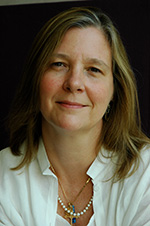Solving Environmental Problems with Science
Northwestern professor Kimberly Gray talks about climate change, sustainability, and being a research preceptor for Master of Biotechnology program (MBP) students.
Professor Kimberly Gray is the Chair of Civil & Environmental Engineering at Northwestern University, where her research is focused on environmental catalysis and physiochemical processes in natural and engineered environmental systems. She specifically focuses on energy and sustainability applications.
 Gray is one of the dozens of Northwestern faculty members who serve as research preceptors for students in Northwestern's Master of Biotechnology program (MBP). Gray took a few minutes to talk about her background and what she hopes MBP students learn from working with her.
Gray is one of the dozens of Northwestern faculty members who serve as research preceptors for students in Northwestern's Master of Biotechnology program (MBP). Gray took a few minutes to talk about her background and what she hopes MBP students learn from working with her.
How do you describe your research to someone with little understanding of civil or environmental engineering?
All my work starts with an environmental problem to which I bring a deep understanding of chemistry. I work on issues of water and air quality, public health, energy, resource recovery, and urban sustainability. For instance, we are developing new membrane materials that resist microbial attachment and maintain high rates of water production. We are exploring integrated technologies that we refer to as an “urban biorefinery” to convert plant debris into energy and chemical products. We are developing photoactive thin films to combat hospital-borne infections. Finally, we are exploring the unintended stress or toxic effects of nanomaterials in natural waters.
What do you enjoy most about your research?
I am most proud of our work to reinvent the energy and material flow in cities to something less carbon-intensive and more resilient and adaptive. In addition, I enjoy the public health benefits of our work.
What do you hope students who do research with you learn from the experience?
I hope that students learn to embrace an open-ended problem where we make unexpected and surprising discoveries. And I hope they learn the joy of serendipity — lots of things do not turn out as we expect, but there can be an enormous opportunity in both positive and negative results.
What are one or two sustainability-related statistics that you think would surprise most people?
Climate experts believe that we need to begin to chart a decrease in CO2 emissions by 2020 to reach net-zero by 2050. Yet, global CO2 emission increased by 2.7 % in 2018 and in the U.S. emissions increased by 3.4%.
With a rapidly changing climate, we can expect more intense and possibly more extreme events. More people die from heat-related weather events than all other extreme weather events combined. Climate action in cities is the centerpiece of my research program.
What misconceptions, if any, do you think exist about sustainability as a whole?
Sustainability is an overused word that tends to mean so much, that in the end, it means almost nothing. But I believe this is a principle-based idea rooted in ecological principles that we can measure.

